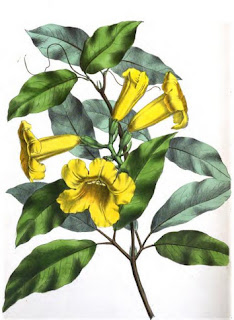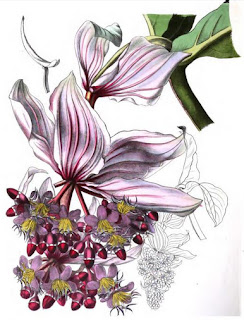William Morris´ design. Kelmscott Press
Tempted by Nick´s Bilton article Deciding on a book, and how to read it, I asked my son to show me how a book could be read in his Android cell phone. I didn´t like what I´ve seen, small paragraphs in a small screen, though I understand one could get the habit of reading this way. I still prefer a printed book. Let´s read an excerpt from The Ideal Book: an address by William Morris, delivered before the Bibliographical Society of London MDCCCXCIII.
William Morris´ design. Kelmscott Press
By the Ideal Book, I suppose we are to understand a book not limited by commercial exigencies of price: we can do what we like with it, according to what its nature, as a book, demands of art. But we may conclude, I think, that its matter will limit us somewhat; a work on differential calculus, a medical work, a dictionary, a collection of a statesman’s speeches, or a treatise on manures, such books, though they might be handsomely and well printed, would scarcely receive ornament with the same exuberance as a volume of lyrical poems, or a standard classic, or such like. A work on Art, I think, bears less of ornament than any other kind of book (“non bis in idem” is a good motto); again, a book that must have illustrations, more or less utilitarian, should, I think, have no actual ornament at all, because the ornament and the illustration must almost certainly fight.
Still whatever the subject matter of the book may be, and however bare it may be of decoration, it can still be a work of art, if the type be good and attention be paid to its general arrangement. All here present, I should suppose, will agree in thinking an opening of Schœffer’s 1462 Bible beautiful, even when it has neither been illuminated nor rubricated; the same may be said of Schussler, or Jenson, or, in short, of any of the good old printers; their books, without any further ornament than they derived from the design and arrangement of the letters, were definite works of art. In fact a book, printed or written, has a tendency to be a beautiful object, and that we of this age should generally produce ugly books, shows, I fear, something like malice prepense—a determination to put our eyes in our pockets wherever we can.
Well, I lay it down, first, that a book quite unornamented can look actually and positively beautiful, and not merely un-ugly, if it be, so to say, architecturally good, which, by the by, need not add much to its price, since it costs no more to pick up pretty stamps than ugly ones, and the taste and forethought that goes to the proper setting, position, and so on, will soon grow into a habit, if cultivated, and will not take up much of the master printer’s time when taken with his other necessary business.
Now, then, let us see what this architectural arrangement claims of us. First, the pages must be clear and easy to read; which they can hardly be unless, Secondly, the type is well designed; and Thirdly, whether the margins be small or big, they must be in due proportion to the page of the letter.
For clearness of reading the things necessary to be heeded are, first, that the letters should be properly put on their bodies, and, I think, especially that there should be small whites between them; it is curious, but to me certain, that the irregularity of some early type, notably the roman letter of the early printers of Rome, which is, of all roman type, the rudest, does not tend toward illegibility: what does so is the lateral compression of the letter, which necessarily involves the over thinning out of its shape. Of course I do not mean to say that the above-mentioned irregularity is other than a fault to be corrected. One thing should never be done in ideal printing, the spacing out of letters—that is, putting an extra white between them; except in such hurried and unimportant work as newspaper printing, it is inexcusable.
This leads to the second matter on this head, the lateral spacing of words (the whites between them); to make a beautiful page great attention should be paid to this, which, I fear, is not often done. No more white should be used between the words than just clearly cuts them off from one another; if the whites are bigger than this it both tends to illegibility and makes the page ugly. I remember once buying a handsome fifteenth-century Venetian book, and I could not tell at first why some of its pages were so worrying to read, and so commonplace and vulgar to look at, for there was no fault to find with the type. But presently it was accounted for by the spacing: for the said pages were spaced like a modern book, i. e., the black and white nearly equal. Next, if you want a legible book, the white should be clear and the black black. When that excellent[3] journal, the Westminster Gazette, first came out, there was a discussion on the advantages of its green paper, in which a good deal of nonsense was talked. My friend, Mr. Jacobi, being a practical printer, set these wise men right, if they noticed his letter, as I fear they did not, by pointing out that what they had done was to lower the tone (not the moral tone) of the paper, and that, therefore, in order to make it as legible as ordinary black and white, they should make their black blacker—which of course they do not do. You may depend upon it that a gray page is very trying to the eyes.(...)We now come to the position of the page of print on the paper, which is a most important point, and one that till quite lately has been wholly misunderstood by modern, and seldom done wrong by ancient printers, or indeed by producers of books of any kind. On this head I must begin by reminding you that we only occasionally see one page of a book at a time; the two pages making an opening are really the unit of the book, and this was thoroughly understood by the old book producers. I think you will seldom find a book produced before the eighteenth century, and which has not been cut down by that enemy of books (and of the human race), the binder, in which this rule is not adhered to: that the binder edge (that which is bound in) must be the smallest member of the margins, the head margin must be larger than this, the fore larger still, and the tail largest of all. I assert that, to the eye of any man who knows what proportion is, this looks satisfactory, and that no other does so look. But the modern printer, as a rule, dumps down the page in what he calls the middle of the paper, which is often not even really the middle, as he measures his page from the head line, if he has one, though it is not really a part of the page, but a spray of type only faintly staining the head of the paper. Now I go so far as to say that any book in which the page is properly put on the paper is tolerable to look at, however poor the type may be (always so long as there is no “ornament” which may spoil the whole thing), whereas any book in which the page is wrongly set on the paper is intolerable to look at, however good the type and ornaments may be. I have got on my shelves now a Jenson’s Latin Pliny, which, in spite of its beautiful type and handsome painted ornaments, I dare scarcely look at, because the binder (adjectives fail me here) has chopped off two-thirds of the tail margin: such stupidities are like a man with his coat buttoned up behind, or a lady with her bonnet on hind-side foremost.
Before I finish I should like to say a word concerning large-paper copies. I am clean against them, though I have sinned a good deal in that way myself, but that was in the days of ignorance, and I petition for pardon on that ground only. If you want to publish a handsome edition of a book, as well as a cheap one, do so, but let them be two books, and if you (or the public) cannot afford this, spend your ingenuity and your money in making the cheap book as sightly as you can. Your making a large-paper copy out of the small one lands you in a dilemma even if you re-impose the pages for the large paper, which is not often done, I think. If the margins are right for the smaller book they must be wrong for the larger, and you have to offer the public the worse book at the bigger price; if they are right for the large paper they are wrong for the small, and[7] thus spoil it, as we have seen above that they must do; and that seems scarcely fair to the general public (from the point of view of artistic morality) who might have had a book that was sightly, though not high-priced.(...) And, by the way, I wish to make a protest against the superstition that only small books are comfortable to read; some small books are tolerably comfortable, but the best of them are not so comfortable as a fairly big folio, the size, say, of an uncut Polyphilus or somewhat bigger. The fact is, a small book seldom does lie quiet, and you have to cramp your hand by holding it or else put it on the table with a paraphernalia of matters to keep it down, a tablespoon on one side, a knife on another, and so on, which things always tumble off at a critical moment, and fidget you out of the repose which is absolutely necessary to reading; whereas, a big folio lies quiet and majestic on the table, waiting kindly till you please to come to it, with its leaves flat and peaceful, giving you no trouble of body, so that your mind is free to enjoy the literature which its beauty enshrines.(...) The picture-book is not, perhaps, absolutely necessary to man’s life, but it gives us such endless pleasure, and is so intimately connected with the other absolutely necessary art of imaginative literature that it must remain one of the very worthiest things toward the production of which reasonable men should strive.

William Morris´ design. Kelmscott Press
Pictures and text reference:
http://www.gutenberg.org/files/31596/31596-h/31596-h.htm



































